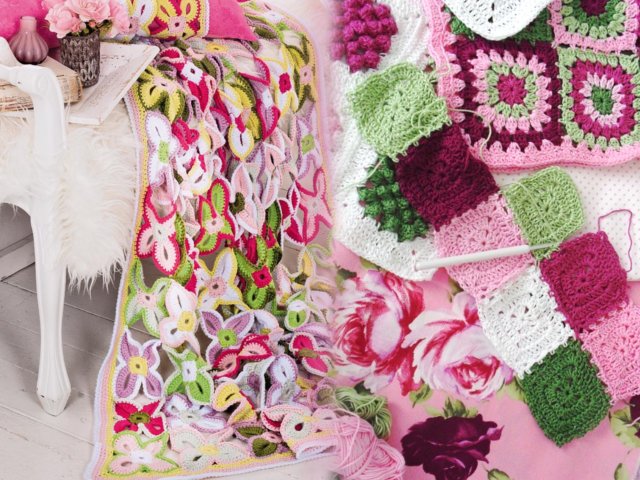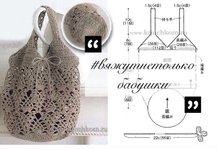
A bedspread is a household item that not only warms the household in bad weather, but is an important element of decor, responsible for the comfort and tranquility of the home environment. Therefore, it is so important to take the choice of bedspreads with all seriousness.
The best option would be to tie a bedspread with your own hands, taking into account the peculiarities of the interior of your home and the taste preferences of households. You can do this with knitting needles, knitting, for example, a beautiful plaid, but you can crochet a bedspread. In the second case, you get a very original product with a beautiful openwork effect.
Crocheted bedspread with patterns and description
In magazines and on websites we find different patterns of knitting bedspreads, however, choosing a product for the home is worth certain criteria. You need to knit a bedspread in accordance with the style of the room, the design of the sofa or bed, taking into account the color scheme of the room and the tastes of the people who spend the most time in it.
It can be a blanket for a newborn - it requires special attention to the selection of knitting patterns and yarn, or it can be a “duty” blanket in the bedroom, living room or guest rooms. In general, there are many styles of knitted blankets, as well as methods of knitting them. Ultimately, it all depends on the desire and imagination of the master.
We will consider some of the many crochet patterns of crocheting, and we will examine in detail the descriptions of the progress of work so that there are no problems during knitting, and the needlewoman could enjoy the process and delight in the result.
Knitting from squares

Nice looking style patchworkseems to never go out of style. It is still used with pleasure in the design industry, because any inclusion of it in the interior instantly adds comfort to everything around. This effect can be achieved, including by crocheting openwork motifs of various shapes. Consider a simple version of how you can create a crochet cover from squares.
Bedspread sizes:
148 x 116 cm.
Materials for work:
- Liska yarn (50% natural wool, 50% polyacrylic; 80 m / 50 g) - 650 g beige, 250 g white, 200 g blue-green and 100 g col. rosewood;
- Maya yarn (63% polyamide, 37% natural wool; 130 m / 50 g) - 100 g each of white and blue-green and 50 g of dark pink;
- Mila yarn (70% polyacrylic, 10% wool, 10% alpaca wool, 10% polyamide; 100 m / 50 g) - 100 g of sand and 50 g of white;
- hook number 5.
We knit patterns for bedspreads.
Square pattern

Run a chain of 8 vp and lock it in the ring using 1 connection. Art. Knit acc. crochet pattern in circular rows. Each circular row to begin with the initial VP according to scheme and complete 1 connection. Art. in the last initial vp or 1 tbsp. s / n, respectively. Perform 1 time of the 1-6th circular rows, observing the alternation of colors. To do this, fasten a new thread with 1 conn. Art.
Lane sequence 1
2 circular rows of Liska beige thread, Mila sand thread and Liska beige thread.
Lane sequence 2
2 circular rows of blue-green thread Liska, Maya and Liska.
Lane sequence 3
2 circular rows of thread col.rosewood Liska, dark pink Maya thread and thread fl. rosewood Liska.
Lane sequence 4
2 circular rows of white thread Liska, Maya and Mila.
Lattice pattern in circular rows.
Alternately 1 tbsp. with 2 / n, 1 v.p. Each circular row to start with 4 starting VP instead of the 1st art. with 2 / n and finish 1 connection. Art. in the last initial vp
Knitting density
- 1 square = 16 x 16 cm;
- 19 p. X 5.5 p. = 10 x 10 cm, connected by a lattice pattern.
Pattern

Working process
Perform 25 squares as per color sequences 1, 9 squares acc. color sequences 2, 6 squares acc. color sequences of 3 and 8 squares acc. color sequences 4.
Assembly
Decompose squares as per pattern 1 (= 6 x 8 squares) and from the front freely connect first across, then along with the help of a joint. Art. beige thread Liska.
For the border, start with a new beige Liska thread and knit 2 circular rows of beige and white Liska thread and 1 circular row with a beige thread with a lattice pattern, while in the 1st circular row at the corners on both sides of the corner st. with 2 / n perform 2 vp and in each next circular row perform at 1 vp more. In the last circular row, perform 3 tbsp. with 2 / n to the corner loop.
Then connect another 1 circular row with “waves” (= * 1 tbsp. B / n, 1 tbsp. S / n, 3 tbsp. With 2 / n, 1 tbsp. S / n, from * constantly repeat, finish 1 connection. Art. in the 1st art. b / n).
For a newborn

The smallest children deserve special attention and care, therefore it is so important to surround them with not only beautiful, but also useful things. It is such products that you need to create with your own hands. For example, you can crochet a bedspread. It is useful for a baby's crib, and for a stroller.
It is important to knit things intended for newborns from gentle soft warming yarn, which will not irritate and soar the skin. This point should not be overlooked when choosing materials for work.
Let us consider in more detail how to crochet a blanket for a newborn, and at the same time a beautiful pillowcase on a pillow for a baby. The style of knitting the bedspreads is beautiful multi-colored triangular crochet motifs.
Bedspread sizes:
- bedspread - about 66 x 66 cm;
- a pillow cover is about 20 x 24 cm.
Materials for work:
- yarn (50% viscose, 50% polyacrylic, 106 m / 50 g) - 200 g gray, 100 g orange and 150 g pink;
- hooks No. 4 and 4,5;
- Pillow 24 x 20 cm.
We knit patterns according to the schemes
Single crochet
Each row to start with VP lifting instead of the 1st art. non-cash and finish the connection. Art. in vp lifting.
Triangles

Knit according to the pattern, start and end the circular rows, as indicated in the pattern.
Repeat from the 1st to the 4th row, while in the 4th row the details are interconnected, as described below.
Half triangle
Knit according to the scheme, rotate the rows, as indicated in the scheme.
Repeat from the 1st to the 4th row, while in the 4th row the details are interconnected, as described below.

Knitting density
- 16 p. X 20 p. = 10 x 10 cm, art. non-cash crochet number 4.5;
- side length of one triangle = 12 cm.
Pattern

Working process
Cover
1st p.: Crochet 5 pink triangles with a No. 4,5 crochet and place them side by side with the same side down.
2nd p.: In the gap between two pink triangles, knit along a gray triangle, and in the 4th row on both sides, along the line from arrow C to A and from arrow A to B, connect them with pink triangles. To do this, in each arch vp instead of the average vp knit 1 connection. Art., as well as to the right and to the left of single art. s / n between two vp knit 1 connection. Art., introducing a hook into an adjacent triangle. Then, on both outer sides, knit with a gray thread along the half of the triangle and in the 4th p. on the one hand, from arrow A to arrow B, connect in the same way with pink triangles.
3rd p.: Tie 4 triangles and 2 halves of triangles with an orange thread and in the 4th p. / Circle. on one side of the whole triangles in a line from arrow A to B and halves of triangles in a line from arrow C to A connect with gray triangles.
4th p.: Between two orange triangles, knit 1 gray triangle and in the 4th p. on both sides, in a line from arrow C to A and from arrow A to B, connect with orange triangles.
5th p.: Connect 5 pink triangles and in the 4th circle on one side, in a line from arrow A to B, connect them with gray triangles.
Repeat again from the 2nd to the 5th row, and then from the 2nd to the 4th row.
Assembly
The bedspread should be crocheted around the perimeter No. 4 with a pink thread 4 circle. Art. non-cash and 1 p. "Crayfish step" (= 1 tbsp. B / n from left to right), while in the 1st circle. on each whole triangle, perform 19 tbsp. b / n, and on each half of the triangle - 15 tbsp. b / n, in the corners of the bedspread always knit 3 tbsp. non-cash
Cushion cover
Crochet the cover No. 4,5 and connect the triangles together, as described above.
1st p .: make 4 triangles of gray color and lay next to each other with the same side down.
2nd p.: Make 4 orange triangles and connect each triangle in the 4th row on both sides with gray triangles, while the 4th orange triangle will be connected on one side with the 1st gray triangle so that you get a ring.
3rd p.: Connect 4 triangles of gray color and in the 4th circle connect them on both sides with orange triangles.
4th p.: Connect 4 pink triangles and, as described above (for the 2nd p.), Connect with gray triangles.
Assembly
Fill the top seam. Open edge to tie with gray thread in one row near st. b / n, while on each triangle to knit 19 tbsp. non-cash Insert the pillow into the cover and complete the remaining seam.
Motive bedspread for a large bed

Of course, in our time there are different standards for the size of beds and bedspreads for them, so it will be difficult to choose something specific to the needs of an individual person. But since knitting blankets, bedspreads and covers for blankets is a flexible work, you can always add what you need or reduce unnecessary to the final result, try to crochet the bedspread on the bed. The scheme and description of crocheting bedspreads from motifs will help in this. This bedspread is knitted with very large lace motifs combined with smaller ones.
Bedspread sizes:
About 140 x 175 cm.
Materials for work:
- yarn (100% cotton, approx. 140 m / 50 g) - approx. 950 g of lilac mottled;
- hook number 4;
- optionally pieces of lilac felt for decoration.
Knitting pattern


Working process:
First link 12 motives II. Then connect 20 motives I, while in the 10th circle. connect them at the picot indicated on the diagram by arrows, using 1 conn. Art. with motives II, and also among themselves.
In width, execute 4 motives I and 3 motives II, in height 5 motives I and 4 motives II, connecting them together.
Assembly
In the middle of the motifs II, as shown in the photo or at random, sew a decor of felt.
How to knit a cover for a children's sofa

When you come to knitting bedspreads from the creative side, you will definitely get an exceptional product that will appeal to both adults and children. Decorating a children's room with a knitted blanket, it is worth taking care of the selection of interesting textures and a combination of colors - so the children's room will immediately be transformed. Let's take a closer look at how to crochet a baby bedspread on a sofa, which is perfect for a girl. This openwork bedspread will consist of round motifs with flowers.
Bedspread sizes:
About 160 x 128 cm.
Materials for work:
- yarn (96% cotton, 4% polyester; 105 m / 50 g) - 800 g blue-gray and 700 g blue;
- hook number 4.
We knit patterns according to the schemes
Power socket

Fold 1 loop from the blue thread and knit in circular rows according to the pattern. Each circular row start with vp according to scheme and finish 1 connection. Art.
Perform 1 time 1-7th circular rows according to. sequence of colors.
Color sequence
1 circular row with blue thread,
2 circular rows of gray-blue, blue and gray-blue thread.
A circle
From a gray-blue thread, fold 1 loop and knit st. b / n in circular rows. Each circular row start with 1 additional initial vp and finish 1 connection. Art. in the 1st art. b / n circular row.
1st circular row: 8 tbsp. non-cash
2nd circular row with blue thread: double each loop = 16 p.
3rd circular row with gray-blue thread: double every 2nd loop = 24 p.
4th circular row with blue thread: double every 3rd loop = 32 p.
5th circular row with gray-blue thread: double every 4th loop = 40 p.
Knitting density:
- socket = diameter 16 cm;
- circle = diameter 6 cm.
Pattern

Working process
Run 80 outlets and 63 laps. We recommend first stretching or slightly steaming outlets and circles.
Sockets acc. Sew the pattern along the marked edges of A. Then sew circles into the holes on the edges of B.
Video tutorial for beginners
A video master class will help to begin work more confidently for any novice knitter. Visual lessons from professionals will facilitate the process of getting used to working with a hook and help to avoid possible mistakes by beginners.
Crochet bedspreads video tutorial:


























